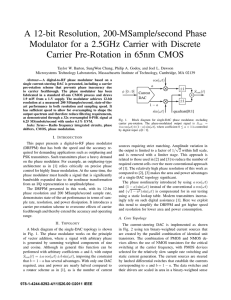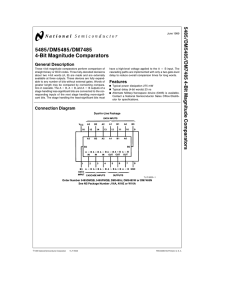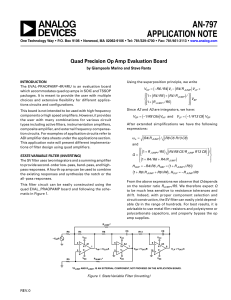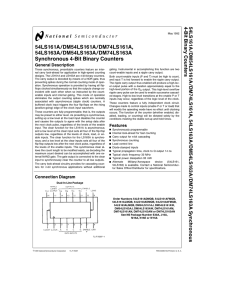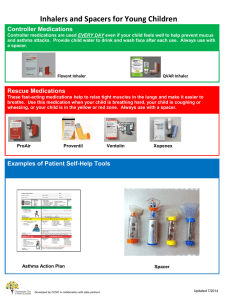TEXAS FSK
Anuncio
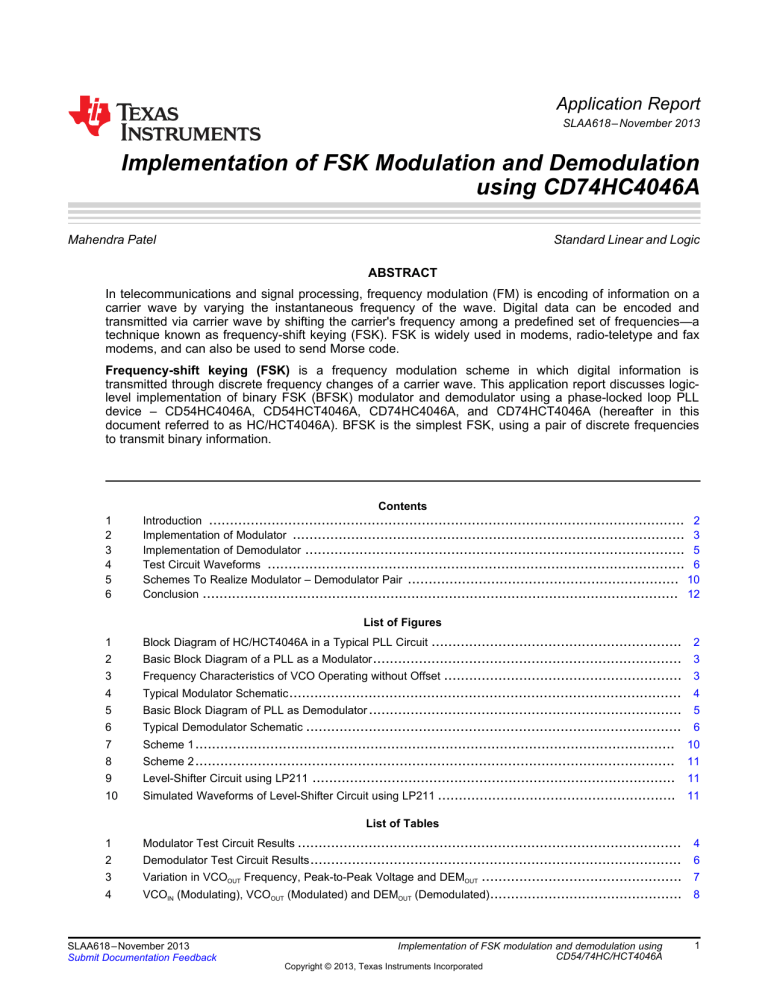
Application Report SLAA618 – November 2013 Implementation of FSK Modulation and Demodulation using CD74HC4046A Mahendra Patel ............................................................................................. Standard Linear and Logic ABSTRACT In telecommunications and signal processing, frequency modulation (FM) is encoding of information on a carrier wave by varying the instantaneous frequency of the wave. Digital data can be encoded and transmitted via carrier wave by shifting the carrier's frequency among a predefined set of frequencies—a technique known as frequency-shift keying (FSK). FSK is widely used in modems, radio-teletype and fax modems, and can also be used to send Morse code. Frequency-shift keying (FSK) is a frequency modulation scheme in which digital information is transmitted through discrete frequency changes of a carrier wave. This application report discusses logiclevel implementation of binary FSK (BFSK) modulator and demodulator using a phase-locked loop PLL device – CD54HC4046A, CD54HCT4046A, CD74HC4046A, and CD74HCT4046A (hereafter in this document referred to as HC/HCT4046A). BFSK is the simplest FSK, using a pair of discrete frequencies to transmit binary information. spacer 1 2 3 4 5 6 Contents Introduction .................................................................................................................. 2 Implementation of Modulator .............................................................................................. 3 Implementation of Demodulator ........................................................................................... 5 Test Circuit Waveforms .................................................................................................... 6 Schemes To Realize Modulator – Demodulator Pair ................................................................. 10 Conclusion .................................................................................................................. 12 List of Figures 1 2 3 4 5 6 7 8 9 10 ............................................................ Basic Block Diagram of a PLL as a Modulator .......................................................................... Frequency Characteristics of VCO Operating without Offset ......................................................... Typical Modulator Schematic .............................................................................................. Basic Block Diagram of PLL as Demodulator ........................................................................... Typical Demodulator Schematic .......................................................................................... Scheme 1 ................................................................................................................... Scheme 2 ................................................................................................................... Level-Shifter Circuit using LP211 ....................................................................................... Simulated Waveforms of Level-Shifter Circuit using LP211 ......................................................... Block Diagram of HC/HCT4046A in a Typical PLL Circuit 2 3 3 4 5 6 10 11 11 11 List of Tables 1 Modulator Test Circuit Results ............................................................................................ 2 Demodulator Test Circuit Results ......................................................................................... 6 3 ................................................ VCOIN (Modulating), VCOOUT (Modulated) and DEMOUT (Demodulated) .............................................. 7 4 Variation in VCOOUT Frequency, Peak-to-Peak Voltage and DEMOUT SLAA618 – November 2013 Submit Documentation Feedback Implementation of FSK modulation and demodulation using CD54/74HC/HCT4046A Copyright © 2013, Texas Instruments Incorporated 4 8 1 Introduction 1 www.ti.com Introduction Many measurement applications (for example, electric and gas meters) require a way to communicate electronically with a central office so that measured data can be reported back to the central office and new tariffs can be set in the remote site. (1) Telephony provides a convenient means of data communication. This application report discusses logic-level implementation of FSK modulator and demodulator using a PLL device HC/HCT4046A. The HC/HCT4046A, PLL with VCO is a high-speed CMOS IC designed for use in general-purpose PLL applications, including frequency modulation, demodulation, discrimination, synthesis, and multiplication. Figure 1 illustrates the functional block diagram of a PLL IC, highlighting the following: • The voltage controlled oscillator (VCO) generates a center frequency locally. • The center frequency is compared with the incoming signal frequency using a phase comparator (PC) • The PC generates an error voltage, Vd, which is fed into VCO after a low-pass filter (LPF) shifting the frequency of VCO to lock with the incoming signal. SIGIN Fi dTi dt (EXT. REF.) Vd PC COMPIN FOSC VCOOUT dTo dt K d (Ti -To ) FILTER F(s) K o VC VCO VCOIN C1 VC DEMOUT R2 R1 Figure 1. Block Diagram of HC/HCT4046A in a Typical PLL Circuit spacer spacer spacer spacer spacer spacer spacer spacer spacer spacer spacer spacer spacer (1) 2 Schematics in this report are only for reference. Precise implementation can vary from country to country and based on the application, transmission media, and so forth. Implementation of FSK modulation and demodulation using CD54/74HC/HCT4046A Copyright © 2013, Texas Instruments Incorporated SLAA618 – November 2013 Submit Documentation Feedback Implementation of Modulator www.ti.com 2 Implementation of Modulator The modulator uses only VCO, as shown in the block diagram illustrated in Figure 2. Values of R1 and C1 determine the frequency range of the VCO and center frequency of operation depends upon VCO input, which is a digital input signal level for a modulator. Hence high (bit1) and low (bit 0) voltage levels of digital input determines actual output frequencies and separation between them. Modulated Signal Center Frequency (R1, C1) VCO Offset (R2) PC Modulator Buffer Digital Signal (to be Modulated) Figure 2. Basic Block Diagram of a PLL as a Modulator To design a modulator with maximum and minimum frequency of fMAX and fMIN respectively, the following steps are required: 1. Given fMAX and fMIN, center frequency fO can be estimated as (fMAX – fMIN) / 2, see Figure 3. fMAX fVCO fo 2fL fMIN MIN 1/2 VCC MAX VVCOIN 2fL = Frequency Lock Range, fo= Center Frequency Figure 3. Frequency Characteristics of VCO Operating without Offset 2. Determine the values of R1 and C1 using figures 11–15 in the device datasheet (SCHS204). Note that the values of these components must satisfy following conditions: (a) 3 kΩ < R1 < 300 kΩ (b) C1 > 40 pF (c) (R1 || R2) > 2.7 kΩ Use of R2 to set the offset frequency is optional and can be left open, if not needed. 3. Figure 16–21 of the device datasheet (SCHS204) gives an estimate of separation between frequencies for the given VCOIN voltage. 1.0 V < VCOIN < 0.9 × VCC is recommended to generate proper oscillation from VCO. SLAA618 – November 2013 Submit Documentation Feedback Implementation of FSK modulation and demodulation using CD54/74HC/HCT4046A Copyright © 2013, Texas Instruments Incorporated 3 Implementation of Modulator www.ti.com 4. An optional LPF (R3-C2, illustrated in Figure 4) is included to minimize noise at the VCOIN pin. The 3dB cut off frequency of this filter should be 10 times or higher than the maximum bit rate of the modulating signal. VCC_5V VCC TP2 1 2 JP4 1 2 JP3 1 2 R4 10k PCP out PC1out COMPin VCOout INH C1A C1B GND VCC PC3out SIGin PC2out R2 R1 DEMout VCOin 16 15 14 13 12 11 10 9 VCC R2 R1 R3 2 C1 1 2 3 4 5 6 7 8 CD74HC4046A U1 C2 1 TP1 Figure 4. Typical Modulator Schematic Example: A test circuit (VCC = 5 V) was implemented to modulate a digital signal with the following component values: R1 = 3 kΩ, C1 = 47 pF, R2 = open, R3 = 0 Ω, C2 = open Table 1. Modulator Test Circuit Results VCOIN (V) Frequency of VCOOUT (Hz) VCOOUT peak to peak (V) 1.0 8.22 M 4.6 2. 2.5 17.24 M 3.1 3. 4.5 27.93 M 2.2 1. Therefore, by choosing logic 0 as 1 V and logic 1 as 4.5 V, a frequency separation of 19.7 MHz can be obtained. In a practical circuit, frequency separation depends upon the bandwidth availability of the transmission media. Therefore, by choosing an appropriate offset frequency and voltage level of the VCOIN signal, expected modulation can be achieved. 4 Implementation of FSK modulation and demodulation using CD54/74HC/HCT4046A Copyright © 2013, Texas Instruments Incorporated SLAA618 – November 2013 Submit Documentation Feedback Implementation of Demodulator www.ti.com With an increase in VCOIN (CH1) voltage, the frequency of oscillation increases and VCOOUT peak-to-peak voltage (CH2) decreases as shown in Waveform 1. Waveform 1. VCOIN (CH1) Voltage and VCOOUT Peak-to-Peak (CH2) Variation 3 Implementation of Demodulator The demodulator operates in closed-loop mode with the PC and an external LPF, as shown in Figure 5. Modulated Signal Center Frequency (R1, C1) VCO Offset (R2) Demodulated Signal Buffer PC LPF (R3, C2) Demodulator Figure 5. Basic Block Diagram of PLL as Demodulator To design a demodulator with maximum and minimum frequency of fMAX and fMIN, respectively (which is same as that of modulator), the following steps are required: 1. Use the same value of R1 and C1 as that of modulator. 2. While using PC1, the capture range depends on the LPF (R3-C2) characteristics and can be made as large as the lock range. For PC2, capture range is equal to lock range and is independent of the LPF. 3. Since leakage current can affect the VDEMOUT, a load resistor (R5) from this pin to GND in the range of 50 kΩ to 300 kΩ is recommended. SLAA618 – November 2013 Submit Documentation Feedback Implementation of FSK modulation and demodulation using CD54/74HC/HCT4046A Copyright © 2013, Texas Instruments Incorporated 5 Test Circuit Waveforms www.ti.com A typical demodulator schematic is illustrated in Figure 6. VCC_5V 1 JP4 1 2 JP3 1 2 2 JP2 R4 10k C1 1 2 3 4 5 6 7 8 VCC PCP out PC1out COMPin VCOout INH C1A C1B GND CD74HC4046A U1 VCC PC3out SIGin PC2out R2 R1 DEMout VCOin 16 15 14 13 12 11 10 9 VCC 1 2 TP1 R2 R1 1 2 TP2 R5 R3 C2 50k JP1 1 2 3 6 5 4 Figure 6. Typical Demodulator Schematic Example: A test circuit (VCC = 5 V) was implemented to demodulate a digital signal using PC2 with following component values: R1 = 3 kΩ, C1 = 47 pF, R2 = open, R3 = 36 kΩ, C2 = 120 pF Table 2. Demodulator Test Circuit Results VCOIN (V) at Modulator Frequency of SIGIN (Hz) at Demodulator SIGIN peak to peak (V) at demodulator DEMOUT (V) at modulator 1.28 1. 1.0 8.22M 4.6 2. 2.5 17.24M 3.1 2.5 3. 4.5 27.93M 2.2 3.76 Therefore, by choosing 3.5 Vp-p VCOIN and frequency separation of 19.7 MHz at modulator, DEMOUT of (3.76 – 1.28) = 2.48 Vp-p can be obtained. 4 Test Circuit Waveforms The waveforms in Table 3 show variations in the following when VCOIN voltage is changed: (a) VCOOUT frequency (b) Peak-to-peak voltage of modulator VCOOUT or SIGIN of demodulator (c) Corresponding DEMOUT voltage The waveforms in Table 4 show VCOIN (level-shifted digital modulating signal), VCOOUT (modulated signal) and corresponding DEMOUT (demodulated signal) at different frequencies of digital signal. 6 Implementation of FSK modulation and demodulation using CD54/74HC/HCT4046A Copyright © 2013, Texas Instruments Incorporated SLAA618 – November 2013 Submit Documentation Feedback Test Circuit Waveforms www.ti.com Table 3. Variation in VCOOUT Frequency, Peak-to-Peak Voltage and DEMOUT Condition at Modulator 1. Demodulator Waveforms: CH1: SIGIN and CH2: DEMOUT VCOIN = 1 V Waveform 2 2. VCOIN = 2.5 V Waveform 3 3. VCOIN = 4.5 V Waveform 4 SLAA618 – November 2013 Submit Documentation Feedback Implementation of FSK modulation and demodulation using CD54/74HC/HCT4046A Copyright © 2013, Texas Instruments Incorporated 7 Test Circuit Waveforms www.ti.com Table 4. VCOIN (Modulating), VCOOUT (Modulated) and DEMOUT (Demodulated) 1. VCOIN DEMOUT Peak to peak (V)=3.44 V, Frequency = 1 kHz Peak to peak (V) = 3.12 V, Mean (V) = 2.74 V Waveforms: CH1: VCOIN, CH2: VCOOUT, CH3: DEMOUT Waveform 5 2. Peak to peak (V) = 3.52 V, Frequency = 5 kHz Peak to peak (V) = 3.20 V, Mean (V) = 2.62 V Waveform 6 3. Peak to peak (V) = 3.60 V, Frequency = 10 kHz Peak to peak (V) = 3.28 V, Mean (V) = 2.64 V Waveform 7 8 Implementation of FSK modulation and demodulation using CD54/74HC/HCT4046A Copyright © 2013, Texas Instruments Incorporated SLAA618 – November 2013 Submit Documentation Feedback Test Circuit Waveforms www.ti.com Table 4. (continued) 4. VCOIN DEMOUT Peak to peak (V) = 3.60 V, Frequency = 20 kHz Peak to peak (V) = 3.12 V, Mean (V) = 2.69 V Waveforms: CH1: VCOIN, CH2: VCOOUT, CH3: DEMOUT Waveform 8 5. Peak to peak (V) = 3.52 V, Frequency = 30 kHz Peak to peak (V) = 3.04 V, Mean (V) = 2.72 V Waveform 9 6. Peak to peak (V) = 3.52 V, Frequency = 40 kHz Peak to peak (V) = 2.88 V, Mean (V) = 2.71 V Waveform 10 It can be concluded from Waveforms 5 through 9, that it is difficult to use the DEMOUT signal as it is, at higher frequency of modulating signal. Hence, a Schmitt trigger can be used with appropriate threshold and hysteresis to get a clean demodulated signal with sharp rising and falling edges. SLAA618 – November 2013 Submit Documentation Feedback Implementation of FSK modulation and demodulation using CD54/74HC/HCT4046A Copyright © 2013, Texas Instruments Incorporated 9 Schemes To Realize Modulator – Demodulator Pair 5 www.ti.com Schemes To Realize Modulator – Demodulator Pair This section briefly describes various FSK modulation-demodulation schemes. It is important to consider the limitations of each technique before using it for a specific application. In each case, frequency used to represent digital data after FSK modulation should be hundred folds or higher than that of digital data rate to ensure correct bit duration for each bit after demodulation. 5.1 Scheme 1 In this scheme, VCO at the modulator transmits a particular frequency during occurrences of bit 1 in the digital data and remains idle during occurrence of bit 0. At the demodulator end, the presence or absence of the frequency is tracked by the PLL. PC output followed by LPF, represents the demodulated signal, which is the equivalent of the original digital information. For this scheme, VCOIN < 0.6 V for logic 0 and VCOIN close to 0.9 × VCC for logic 1 is recommended. Use of PC2 at the demodulator gives good results over a wide range of frequency. - 0 1 1 0 - Modulator Digital Modulating Signal 0 1 1 0 - Demodulator Modulated Signal Demodulated Signal Figure 7. Scheme 1 Advantages: • Power consumption is less at the modulator. • A burst of frequency is transmitted only during transmission of a specific data bit (either 1 or 0), hence, there is less noise created in the transmission media. • Single frequency is used; therefore, the bandwidth requirement is smaller. • Gives better performance even at higher frequencies (200 kbps or higher) of modulating signal (as compared to scheme 2), because of wide separation possible between logic 0 and logic 1 voltages. Limitations: • It is difficult to determine if the remote modulator is defunct (versus continuously sending 0’s). • When VCOIN < 0.6 V (logic 0), modulator output may either be 0 V or VCC; however, this does not affect demodulation. 10 Implementation of FSK modulation and demodulation using CD54/74HC/HCT4046A Copyright © 2013, Texas Instruments Incorporated SLAA618 – November 2013 Submit Documentation Feedback Schemes To Realize Modulator – Demodulator Pair www.ti.com 5.2 Scheme 2 In this scheme, VCO at the modulator transmits one particular frequency during occurrences of bit 1 in the digital data and other frequency during occurrence of bit 0. At the demodulator end, the change in the frequency is tracked by the PLL. PC output followed by LPF represents the demodulated signal, which is the equivalent of the original digital information. For this scheme, 1.0 V < VCOIN < 0.9 VCC is required. Use of PC2 at the demodulator gives good results over a wide range of frequency. - 0 1 1 0 - Modulator 0 1 1 0 - Demodulator Digital Modulating Signal Modulated Signal Demodulated Signal Figure 8. Scheme 2 Level shifting of the input digital signal is required to meet the VCOIN input range which can be achieved using a level-shifter circuit. + 5 R5 10k U1 LP211/301 3 ± R1 10k + 2 + + Level shifted signal to VCOin 7 1 VDD 3.3 + VCC 5 R6 2.7k + R2 10k 8 Vin 4 R3 5k R7 90k VCC Figure 9. Level-Shifter Circuit using LP211 Figure 10. Simulated Waveforms of Level-Shifter Circuit using LP211 As can be seen from the test waveform in Figure 10, a digital signal Vin (0 V–3.3 V) is converted to VCOIN (1.07 V–4.5 V). SLAA618 – November 2013 Submit Documentation Feedback Implementation of FSK modulation and demodulation using CD54/74HC/HCT4046A Copyright © 2013, Texas Instruments Incorporated 11 Conclusion www.ti.com Advantages: • It is easy to determine if the remote modulator is defunct. Limitations: • Power consumption is more at the modulator due to continuous oscillations. • Requires more bandwidth • As VCOIN logic 0 and logic1 voltage level separation decreases, noise on the demodulated output appears to increase. 6 Conclusion This application report described logic-level implementation of BFSK modulator and demodulator using HC/HCT4046A devices. However, while implementing this circuit for a real-time application, the following important factors must be considered for a reliable communication link: • Output impedance of the modulator • Characteristic impedance of the transmission media • Frequency response of transmission media • Input impedance of the demodulator Hence, impedance matching and signal conditioning becomes an important aspect in a practical system. 12 Implementation of FSK modulation and demodulation using CD54/74HC/HCT4046A Copyright © 2013, Texas Instruments Incorporated SLAA618 – November 2013 Submit Documentation Feedback IMPORTANT NOTICE Texas Instruments Incorporated and its subsidiaries (TI) reserve the right to make corrections, enhancements, improvements and other changes to its semiconductor products and services per JESD46, latest issue, and to discontinue any product or service per JESD48, latest issue. Buyers should obtain the latest relevant information before placing orders and should verify that such information is current and complete. All semiconductor products (also referred to herein as “components”) are sold subject to TI’s terms and conditions of sale supplied at the time of order acknowledgment. TI warrants performance of its components to the specifications applicable at the time of sale, in accordance with the warranty in TI’s terms and conditions of sale of semiconductor products. Testing and other quality control techniques are used to the extent TI deems necessary to support this warranty. Except where mandated by applicable law, testing of all parameters of each component is not necessarily performed. TI assumes no liability for applications assistance or the design of Buyers’ products. Buyers are responsible for their products and applications using TI components. To minimize the risks associated with Buyers’ products and applications, Buyers should provide adequate design and operating safeguards. TI does not warrant or represent that any license, either express or implied, is granted under any patent right, copyright, mask work right, or other intellectual property right relating to any combination, machine, or process in which TI components or services are used. Information published by TI regarding third-party products or services does not constitute a license to use such products or services or a warranty or endorsement thereof. Use of such information may require a license from a third party under the patents or other intellectual property of the third party, or a license from TI under the patents or other intellectual property of TI. Reproduction of significant portions of TI information in TI data books or data sheets is permissible only if reproduction is without alteration and is accompanied by all associated warranties, conditions, limitations, and notices. TI is not responsible or liable for such altered documentation. Information of third parties may be subject to additional restrictions. Resale of TI components or services with statements different from or beyond the parameters stated by TI for that component or service voids all express and any implied warranties for the associated TI component or service and is an unfair and deceptive business practice. TI is not responsible or liable for any such statements. Buyer acknowledges and agrees that it is solely responsible for compliance with all legal, regulatory and safety-related requirements concerning its products, and any use of TI components in its applications, notwithstanding any applications-related information or support that may be provided by TI. Buyer represents and agrees that it has all the necessary expertise to create and implement safeguards which anticipate dangerous consequences of failures, monitor failures and their consequences, lessen the likelihood of failures that might cause harm and take appropriate remedial actions. Buyer will fully indemnify TI and its representatives against any damages arising out of the use of any TI components in safety-critical applications. In some cases, TI components may be promoted specifically to facilitate safety-related applications. With such components, TI’s goal is to help enable customers to design and create their own end-product solutions that meet applicable functional safety standards and requirements. Nonetheless, such components are subject to these terms. No TI components are authorized for use in FDA Class III (or similar life-critical medical equipment) unless authorized officers of the parties have executed a special agreement specifically governing such use. Only those TI components which TI has specifically designated as military grade or “enhanced plastic” are designed and intended for use in military/aerospace applications or environments. Buyer acknowledges and agrees that any military or aerospace use of TI components which have not been so designated is solely at the Buyer's risk, and that Buyer is solely responsible for compliance with all legal and regulatory requirements in connection with such use. TI has specifically designated certain components as meeting ISO/TS16949 requirements, mainly for automotive use. In any case of use of non-designated products, TI will not be responsible for any failure to meet ISO/TS16949. Products Applications Audio www.ti.com/audio Automotive and Transportation www.ti.com/automotive Amplifiers amplifier.ti.com Communications and Telecom www.ti.com/communications Data Converters dataconverter.ti.com Computers and Peripherals www.ti.com/computers DLP® Products www.dlp.com Consumer Electronics www.ti.com/consumer-apps DSP dsp.ti.com Energy and Lighting www.ti.com/energy Clocks and Timers www.ti.com/clocks Industrial www.ti.com/industrial Interface interface.ti.com Medical www.ti.com/medical Logic logic.ti.com Security www.ti.com/security Power Mgmt power.ti.com Space, Avionics and Defense www.ti.com/space-avionics-defense Microcontrollers microcontroller.ti.com Video and Imaging www.ti.com/video RFID www.ti-rfid.com OMAP Applications Processors www.ti.com/omap TI E2E Community e2e.ti.com Wireless Connectivity www.ti.com/wirelessconnectivity Mailing Address: Texas Instruments, Post Office Box 655303, Dallas, Texas 75265 Copyright © 2013, Texas Instruments Incorporated
